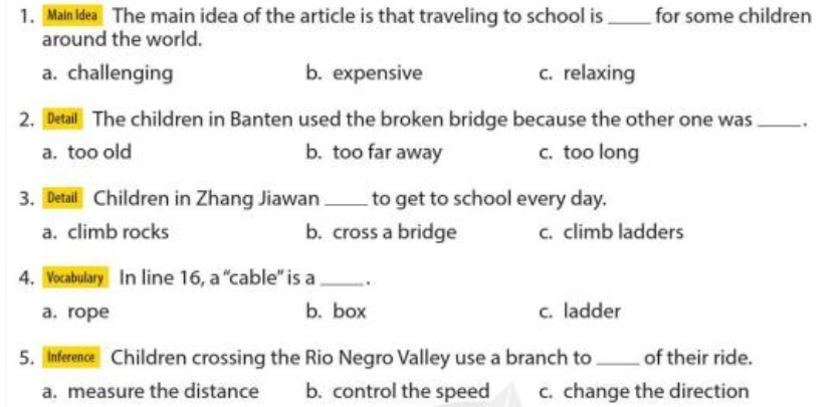Answer the questions about An Unusual Commute. ( Trả lời câu hỏi về An Unusual Commute)

Câu hỏi trong đề: Bài tập Tiếng anh 7 Unit 9. Reading có đáp án !!
Quảng cáo
Trả lời:
|
1-a |
2-b |
3-c |
|
4-a |
5-b |
|
Hướng dẫn dịch
1. Ý chính của bài ăn trên là việc đi đến trường thì nguy hiểm với một số nơi trên thế giới
2. Trẻ con ở Baten sử dụng cây cầu hư hỏng bở vì những cái khác ở quá xa
3. Trẻ con ở Zhang Jiawan leo thang để đến trường hàng ngày
4. Ở dòng 16, “cable” nghĩa là dây thừng
5. Trẻ em đi qua thung lũng Rio Nergo sử dụng các cành để điều chỉnh tốc độ
Hot: 1000+ Đề thi cuối kì 1 file word cấu trúc mới 2025 Toán, Văn, Anh... lớp 1-12 (chỉ từ 60k). Tải ngay
CÂU HỎI HOT CÙNG CHỦ ĐỀ
Lời giải
Hướng dẫn làm bài
I usually go to school on foot.
I leave my house at fifteen to seven in the morning. It takes me about ten minutes to get to school. The streets are not so busy at that time. I get to school at five to seven. I enjoy walking to school with my friends. What about you?
Hướng dẫn dịch
Tớ thường đi bộ đến nhà.
Tờ rời nhà vào lúc 7 giớ kém 15 vào buổi sáng. Tớ mất khoảng 10 phút để đến trường. Vào lúc đó đường phố không quá đống đúc. Tớ đến trường lúc 7 giờ kém 5. Tớ thích đi bộ đến trường cùng với bạn của mình. Còn cậu thì sao?
Lời giải
Hướng dẫn làm bài
How do you go to school?
I go to school by bike
Hướng dẫn dịch
(Bạn đi đến trường bằng phương tiện gì vậy?
Tớ đi đến trường bằng xe đạp)
Lời giải
Bạn cần đăng ký gói VIP ( giá chỉ từ 199K ) để làm bài, xem đáp án và lời giải chi tiết không giới hạn.
Lời giải
Bạn cần đăng ký gói VIP ( giá chỉ từ 199K ) để làm bài, xem đáp án và lời giải chi tiết không giới hạn.
Lời giải
Bạn cần đăng ký gói VIP ( giá chỉ từ 199K ) để làm bài, xem đáp án và lời giải chi tiết không giới hạn.
Lời giải
Bạn cần đăng ký gói VIP ( giá chỉ từ 199K ) để làm bài, xem đáp án và lời giải chi tiết không giới hạn.